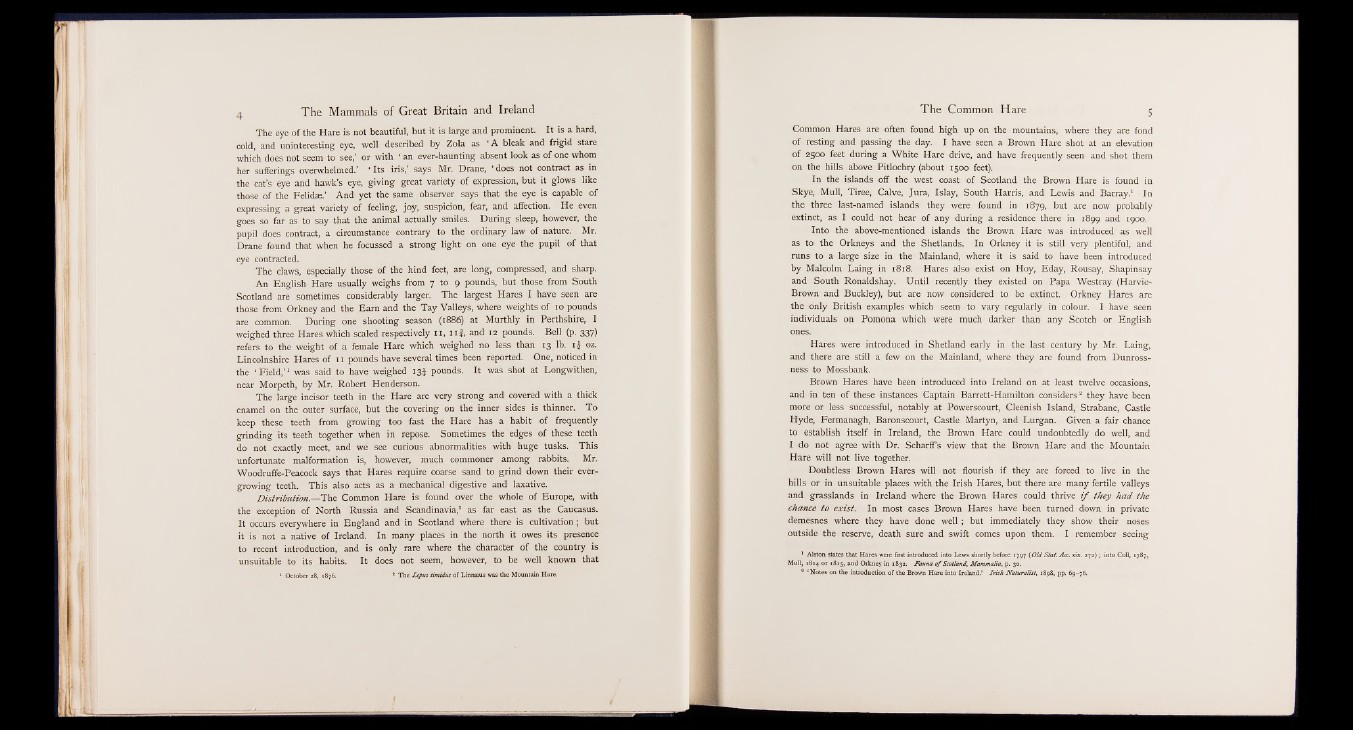
The eye of the Hare is not beautiful, but it is large and prominent. It is a hard,
cold, and uninteresting eye, well described by Zola as ‘ A bleak and frigid stare
which does not seem to see,' or with ‘ an ever-haunting absent look as of one whom
her sufferings overwhelmed.1 ‘ Its iris,’ says Mr. Diane, ‘ does not contract as in
the cat’s eye and hawk’s eye, giving great variety of expression, but it glows like
those of the Felidae.’ And yet the same observer says that the eye is capable of
expressing a great variety of feeling, joy, suspicion, fear, and affection. He even
g o e s lli far as to say that the animal actually smiles. During sleep, however, the
pupil does contract, a circumstance contrary to the ordinary law of nature. Mr.
Drane found that when he focussed a strong light on one eye the pupil of that
eye contracted.
The claws, especially those of the hind feet, are long, compressed, and sharp.
An English Hare usually weighs from 7 to 9 pounds, but those from South
Scotland are sometimes considerably larger. The largest Hares I have seen are
those from Orkney and the Earn and the Tay Valleys, where weights of 10 pounds
are common. During one shooting season (1886) at Murthly in Perthshire, I
weighed three Hares which scaled respectively 11, 1 if , and 12 pounds. Bell (p. 337)
refers to the weight of a female Hare which weighed no less than 13 lb. U oz.
Lincolnshire Hares of 11 pounds have several times been reported. One, noticed in
the ‘ Field,’ 1 was said to have weighed 13I pounds.— It was shot at Longwithen,
near Morpeth, by Mr. Robert Henderson.
The large incisor teeth in the Hare are very strong and covered with a thick
enamel on the outer surface, but the covering on the inner sides is thinner. To
keep these teeth from growing too fast the Hare has a habit of frequently
grinding its teeth together when in repose. Sometimes the edges of these teeth
do not exactly meet, and we see curious abnormalities with huge tusks. This
unfortunate malformation is, however, much commoner among rabbits. Mr.
Woodruffe-Peacock says that Hares require coarse sand to grind down their evergrowing
teeth. This also acts as a mechanical digestive and laxative.
Distribution.— The Common Hare is found over the whole of Europe, with
the exception of North Russia and Scandinavia,* as far east as the Caucasus.
It occurs everywhere in England and in Scotland where there is cultivation; but
it is not a native of Ireland. In many places in the north it owes its presence
to recent introduction, and is only rare where the character of the country is
unsuitable to its habits. It does not seem, however, to be well known that
4 The Lepus timidus October 28, 1876. of Linnaeus was the Mountain Hare.
Common Hares are often found high up on the mountains, where they are fond
of resting and passing the day. I have seen a Brown Hare shot at an elevation
of 2500 feet during a White Hare drive, and have frequently seen and shot them
on the hills above Pitlochry (about 1500 feet).
In the islands off the west coast of Scotland the Brown Hare is found in
Skye, Mull, Tiree, Calve, Jura, Islay, South Harris, and Lewis and Barray.1 In
the three last-named islands they were found in 1879, but are now probably
extinct, as I could not hear of any during a residence there in 1899 and 1900.
Into the above-mentioned islands the Brown Hare was introduced as well
as to the Orkneys and the Shetlands. In Orkney it is still very plentiful, and
runs to a large size in the Mainland, where it is said to have been introduced
by Malcolm Laing in 1818. Hares also exist on Hoy, Eday, Rousay, Shapinsay
and South Ronaldshay. Until recently they existed on Papa Westray (Harvie-
Brown and Buckley), but are now considered to be extinct. Orkney Hares are
the only British examples which seem to vary regularly in colour. I have seen
individuals on Pomona which were much darker than any Scotch or English
ones.
Hares were introduced in Shetland early in the last century by Mr. Laing,
and there are still a few on the Mainland, where they are found from Dunross-
ness to Mossbank.
Brown Hares have been introduced into Ireland on at least twelve occasions,
and in ten of these instances Captain Barrett-Hamilton considers2 they have been
more or less successful, notably at Powerscourt, Cleenish Island, Strabane, Castle
Hyde, Fermanagh, Baronscourt, Castle Martyn, and Lurgan. Given a fair chance
to establish itself in Ireland, the Brown Hare could undoubtedly do well, and
I do not agree with Dr. ScharfFs view that the Brown Hare and the Mountain
Hare will not live together.
Doubtless Brown Hares will not flourish if they are forced to live in the
hills or in unsuitable places with the Irish Hares, but there are many fertile valleys
and grasslands in Ireland where the Brown Hares could thrive i f they had the
chance to exist. In most cases Brown Hares have been turned down in private
demesnes where they have done well ; but immediately they show their noses
outside the reserve, death sure and swift comes upon them. I remember seeing
1 Alston states that Hares were first introduced into Lews shortly before 1797 {Old Stat.Acc. xix. 272); into Coll, 1787,
Mull, 1814 or 1815, and Orkney in 1832. Fauna o f Scotland, Mammalia, p. 30.
4 ‘ Notes on the introduction of the Brown Hare into Ireland.’ Irish N a tu ra list1898, pp. 69-76.